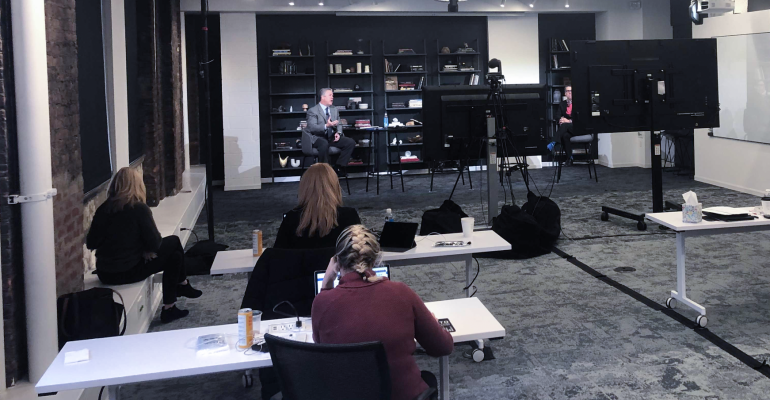Typically, the top executives for STO Building Group, a consortium of about 20 regional construction companies, attend each company’s Q4 event to speak and mingle with local leadership and employees. But this year, those regional events were canceled, replaced by a one-day hybrid event. The consortium’s five top executives presented to a small audience of corporate-office employees in a studio at a Convene meeting venue in New York, and those presentations were beamed to each company’s office while field employees could also tune in via their laptops.
Rebecca Leonardis, STO’s vice president of marketing and communications, coordinated the December hybrid event on eight weeks’ notice. First, she worked with Convene to set up a website for employees to log into a week ahead of the event. It contained the event agenda, some personal facts about each presenting executive, topical videos for on-demand viewing, and even the company’s latest magazine issue. “It was a bigger experience rather than just a one-off meeting,” Leonardis says.
For the day of event, “We had each company do a three-minute video update, and we grouped those together five at a time. So, we alternated each 15-minute executive presentation with 15 minutes of regional-company videos,” she says. “Those were recorded ahead of time, but we made sure they looked like live presentations through their content-delivery style and background.”
From there, a polling question and Q&A session allowed virtual attendees to engage with executives. “We used the chat app Slido to take questions, and we had someone monitoring the questions and presenting the best ones to our executives,” Leonardis says. “We did a dry run the day before so everyone on site would be comfortable with the flow, and we prepared leadership to explain things well in their answers.”
What’s more, the two-hour event was scripted in a way that allowed the executive team to provide the transitions into each new segment. “We didn’t want a professional emcee; it worked out well because we did a rehearsal to get our leadership comfortable with the layout screens and camera set-up," Leonardis says. "There were a few moments of directing them, where we needed to signal with our hands or hold up a sign behind the camera.”
Because the event used only one camera, “it was a challenge—we had to pan back and forth a lot and then pull back so the socially distanced executives could all fit on screen. Next time, we will have a second camera.”
Almost 80 percent of the consortium’s 3,000 employees tuned into the hybrid event. “The feedback was great; people said they want us to do this format again,” says Leonardis. “And when our executives can travel, we will look into having other broadcast sites too.”





